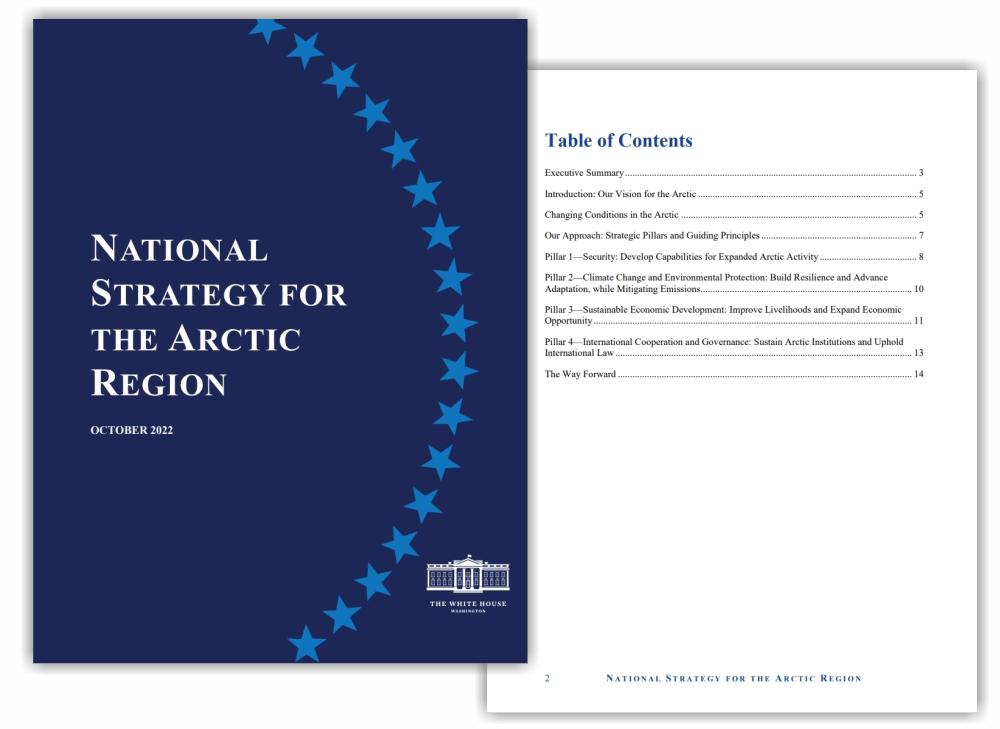The United States recently published its new National Strategy for the Arctic Region. This strategy is an update of its 2013 predecessor.
The Executive Summary of the Strategy: The United States seeks an Arctic region that is peaceful, stable, prosperous, and cooperative. The National Strategy for the Arctic Region articulates an affirmative U.S. agenda over the next ten years, from 2022 to 2032, to realize this vision. This strategy, an update of its 2013 predecessor, addresses the climate crisis with greater urgency and directs new investments in sustainable development to improve livelihoods for Arctic residents while conserving the environment. It also acknowledges increasing strategic competition in the Arctic since 2013, exacerbated by Russia’s unprovoked war in Ukraine, and seeks to position the United States to both effectively compete and manage tensions.
Realizing our vision during this dynamic and challenging period will require U.S. leadership at home and abroad. We will advance U.S. interests across four mutually reinforcing pillars spanning both domestic and international issues.
- Pillar 1 — Security: We will deter threats to the U.S. homeland and our allies by enhancing the capabilities required to defend our interests in the Arctic, while coordinating shared approaches with allies and partners and mitigating risks of unintended escalation. We will exercise U.S. government presence in the Arctic region as required to protect the American people and defend our sovereign territory.
- Pillar 2 — Climate Change and Environmental Protection: The U.S. government will partner with Alaskan communities and the State of Alaska to build resilience to the impacts of climate change, while working to reduce emissions from the Arctic as part of broader global mitigation efforts, to improve scientific understanding, and to conserve Arctic ecosystems.
- Pillar 3 — Sustainable Economic Development: We will pursue sustainable development and improve livelihoods in Alaska, including for Alaska Native communities, by investing in infrastructure, improving access to services, and supporting growing economic sectors. We will also work with allies and partners to expand high-standard investment and sustainable development across the Arctic region.
- Pillar 4 — International Cooperation and Governance: Despite the challenges to Arctic cooperation resulting from Russia’s aggression in Ukraine, the United States will work to sustain institutions for Arctic cooperation, including the Arctic Council, and position these institutions to manage the impacts of increasing activity in the region. We also seek to uphold international law, rules, norms, and standards in the Arctic.
This strategy is intended to serve as a framework to guide the U.S. government’s approach to tackling emerging challenges and opportunities in the Arctic. Our work will be guided by five principles that will be applied across all four pillars.
- Consult, Coordinate, and Co-Manage with Alaska Native Tribes and Communities: The United States is committed to regular, meaningful, and robust consultation, coordination, and co-management with Alaska Native Tribes, communities, corporations,and other organizations and to ensuring equitable inclusion of Indigenous Peoples and their knowledge.
- Deepen Relationships with Allies and Partners: We will deepen our cooperation with Arctic Allies and partners: Canada, the Kingdom of Denmark (including Greenland), Finland, Iceland, Norway, and Sweden. We will also expand Arctic cooperation with other countries that uphold international law, rules, norms, and standards in the region.
- Plan for Long-Lead Time Investments: Many of the investments prioritized in this strategy will require long lead times. We will be proactive, anticipating changes coming to the Arctic over the next several decades and making new investments now to be prepared.
- Cultivate Cross-Sectoral Coalitions and Innovative Ideas: The challenges and opportunities in the Arctic cannot be solved by national governments alone. The United States will strengthen and build on coalitions of private sector; academia; civil society; and state, local, and Tribal actors to encourage and harness innovative ideas to tackle these challenges.
- Commit to a Whole of Government, Evidence-Based Approach: The Arctic extends beyond the responsibility of any single region or government agency. U.S. Federal departments and agencies will work together to implement this strategy. We will deploy evidence-based decision-making and carry out our work in close partnership with the State of Alaska; Alaska Native Tribes, communities, corporations, and other organizations; and local communities, as well as with the U.S. Congress.
Secretary Blinken Remarks on National Strategy for the Arctic Region
Source:The White House

